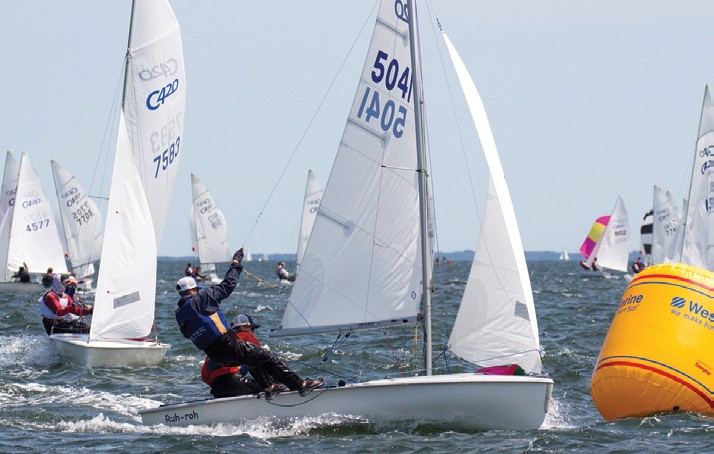By David Dellenbaugh
 If you want your mark roundings to be quick and safe, there are certain strategies that work almost every time. For example, you should round each mark close enough that you could reach out and touch it. You should locate the next mark visually before you round this one. And you should definitely develop a strategic plan for the next leg before you round any mark.
If you want your mark roundings to be quick and safe, there are certain strategies that work almost every time. For example, you should round each mark close enough that you could reach out and touch it. You should locate the next mark visually before you round this one. And you should definitely develop a strategic plan for the next leg before you round any mark.
Round every mark close enough to touch it, like MudRatz 420 sailors Zach Champney (helm) and Peter Cronin, pictured at the Buzzards Bay Regatta. It’s amazing how wide many boats go around marks. In most cases, they lose double the amount of distance they leave between them and the mark. They sail a certain distance past the mark and then they have to sail that far again just to get back to the mark. To minimize distance sailed, it’s important to round close to every mark. Of course, there are a few times when it’s OK to be farther from the mark – like at a windward mark in breeze when you need enough space to ease your main, or at a leeward mark when you are trying to do an ‘end-run’ around a pack of boats. But a good rule of thumb is that you should round each mark close enough that you can reach over and touch it. To get into this position you may have to slow down so you are right behind the boat ahead, but this ensures that you will sail the shortest course, and it gives you more tactical options and clearer air after the mark. © J. Cronin – OutrageousPhotography.net
One reason why it’s important to follow rules of thumb like these is that they help you limit risk during mark roundings. It’s easy to make big gains or losses near marks. If you stick to certain guidelines, it’s easier to navigate through the chaos at marks. By thinking ahead and having a plan, you will add a sense of purpose to the randomness of many mark roundings. And this will help you be more successful consistently.
Before you get to any mark, think ahead about how much risk you’re willing to take. When you are content with your fleet position or if it’s early in the race or series, you’ll probably want to minimize risk at the mark. If you come into a windward mark on port tack, for example, you should probably duck that starboard tacker and overstand slightly on the starboard layline.
But if you’re not happy with how you’re doing and you need to play catch up, then you’d be willing to take more risk. In the same windward mark situation, you might try to leebow that starboard tacker on the layline and hope you can squeeze up around the mark. Here are some more strategies to help minimize risk at marks:
Watch the boats ahead. Keep a close eye on boats that round the mark before you. They will warn you about trouble (e.g. current) and may give you some ideas about how to get around the mark quickly.
Perform maneuvers early. One of the most common, and costliest, mark-rounding mistakes is waiting too long to perform boathandling and sailhandling maneuvers. Be conservative by doing these earlier than you think.
Communicate your rights. Another easy way to lose a lot at marks is to break a rule. Many rule problems can be avoided with better communication.
For example,if you think you have an inside overlap at the zone, yell to the other boat (even before you get to the zone). Either they will agree with you (and you’ll get mark-room) or they will disagree (and then you’ll have to decide if you want to risk forcing your way inside them).
Put on the brakes. Often the best way to be conservative at a mark is by slowing down. Going slower may not seem like a smart strategy for winning a race, but it’s usually better than rushing into a crowd and coming to a dead end. Maintain your tactical options by slowing to avoid getting an overlap on the boat(s) ahead.
Find a happy balance. Good mark roundings often come down to the ability to find a compromise between a bunch of factors. Focus on the crew maneuvers inside your boat, but make sure you also keep your head outside the boat and watch the big picture. Try to be conservative and avoid the risks that come with being greedy, but at the same time stay alert to possible opportunities for making big gains. You must walk the tight rope.
This article originally appeared in David Dellenbaugh’s Speed & Smarts, The newsletter of how-to tips for racing sailors. If you want to sail faster and smarter, log onto SpeedandSmarts.com.
A resident of Easton, CT, Dellenbaugh was tactician and starting helmsman for America3’s successful defense of the America’s Cup in 1992. He’s a Lightning World Champion, two-time Congressional Cup winner, seven-time Thistle National Champion, two-time winner of the Canada’s Cup, three-time Prince of Wales U.S. Match Racing Champion, and a winner of the U.S. Team Racing Championships for the Hinman Trophy.




